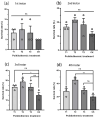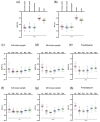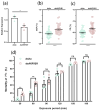Brief Warm and Aldo-Keto Reductase Family AspiAKR1B1 Contribute to Cold Adaptation of Aleurocanthus spiniferus
- PMID: 39859619
- PMCID: PMC11765982
- DOI: 10.3390/insects16010038
Brief Warm and Aldo-Keto Reductase Family AspiAKR1B1 Contribute to Cold Adaptation of Aleurocanthus spiniferus
Abstract
Aleurocanthus spiniferus not only damages plant leaves directly but also causes a sooty blotch due to the honeydew secreted by the nymphs and adults. This pest is widespread and seems to be spreading from low latitude to higher latitude areas where winters are typically colder, indicating an increase in its cold tolerance. Changes in temperature help insects to anticipate the arrival of winter, allowing them to take defensive measures in advance. This study examines the impacts of brief warm pulses on the low-temperature tolerance of A. spiniferus, and analyzes the physiological and biochemical mechanisms underlying its cold adaptation, utilizing seasonal differences in cold tolerance. Intermittent training at 25 °C significantly improved the survival rate of overwintering nymphs (third and fourth instar) at -7 °C. Analysis of seasonal differences in the supercooling point (SCP) and freezing point (FP) revealed that overwintering nymph had the highest cold tolerance in November. Seasonal variation in levels of cold-resistant substances were also observed, with moisture decreasing during overwintering, while fat and glycerol levels increased. Conversely, glucose, sorbitol, and trehalose levels rose significantly at the end of the overwintering period. The expression profile of cold-resistant genes indicated that the aldo-keto reductase family 1 member B1 in Aleurocanthus spiniferus (AspiAKR1B1) shows a significant decrease at the end of the overwintering period. Knocking down AspiAKR1B1 led to a marked reduction in the cold tolerance of A. spiniferus. Therefore, brief warm pulses and AspiAKR1B1 are key factors contributing to the enhanced cold tolerance of A. spiniferus. This research provides theoretical support for preventing the further spread of A. spiniferus to higher latitudes, and offers technical guidance for developing effective pest control measures.
Keywords: Aleurocanthus spiniferus; AspiAKR1B1; cold tolerance; fluctuating thermal regime.
Conflict of interest statement
The authors declare that they have no known competing financial interests or personal relationships that could have appeared to influence the work reported in this paper.
Figures







Similar articles
-
Cold tolerance and metabolism of red-haired pine bark beetle Hylurgus ligniperda (Coleoptera: Curculionidae) during the overwintering period.J Econ Entomol. 2024 Aug 12;117(4):1553-1563. doi: 10.1093/jee/toae137. J Econ Entomol. 2024. PMID: 38956822
-
Characterization of Antennal Chemosensilla and Associated Chemosensory Genes in the Orange Spiny Whitefly, Aleurocanthus spiniferus (Quaintanca).Front Physiol. 2022 Feb 28;13:847895. doi: 10.3389/fphys.2022.847895. eCollection 2022. Front Physiol. 2022. PMID: 35295577 Free PMC article.
-
Overwintering strategy and mechanisms of cold tolerance in the codling moth (Cydia pomonella).PLoS One. 2013 Apr 17;8(4):e61745. doi: 10.1371/journal.pone.0061745. Print 2013. PLoS One. 2013. PMID: 23613923 Free PMC article.
-
Cold tolerance strategy and cryoprotectants of Megabruchidius dorsalis in different temperature and time stresses.Front Physiol. 2023 Jan 11;13:1118955. doi: 10.3389/fphys.2022.1118955. eCollection 2022. Front Physiol. 2023. PMID: 36714316 Free PMC article. Review.
-
Insect overwintering in a changing climate.J Exp Biol. 2010 Mar 15;213(6):980-94. doi: 10.1242/jeb.037911. J Exp Biol. 2010. PMID: 20190123 Review.
References
-
- Mokrane S., Cavallo G., Tortorici F., Romero E., Fereres A., Djelouah K., Verrastro V., Cornara D. Behavioral effects induced by organic insecticides can be exploited for a sustainable control of the orange spiny whitefly Aleurocanthus spiniferus. Sci. Rep. 2020;10:15746. doi: 10.1038/s41598-020-72972-x. - DOI - PMC - PubMed
-
- Radonjić S., Hrnčić S. Spreading of Aleurocanthus spiniferus (Quaintance) (Hemiptera: Aleyrodidae) in coastal area of Montenegro. Acta Hortic. 2021;1308:311–318. doi: 10.17660/ActaHortic.2021.1308.44. - DOI
-
- Gao Y.Q., Chen Z.Z., Liu M.Y., Song C.Y., Jia Z.F., Liu F.H., Qu C., Dewer Y., Zhao H.P., Xu Y.Y., et al. Characterization of antennal chemosensilla and associated chemosensory genes in the orange spiny whitefly, Aleurocanthus spiniferus (Quaintanca) Front. Physiol. 2022;13:847895. doi: 10.3389/fphys.2022.847895. - DOI - PMC - PubMed
Grants and funding
LinkOut - more resources
Full Text Sources
Research Materials

